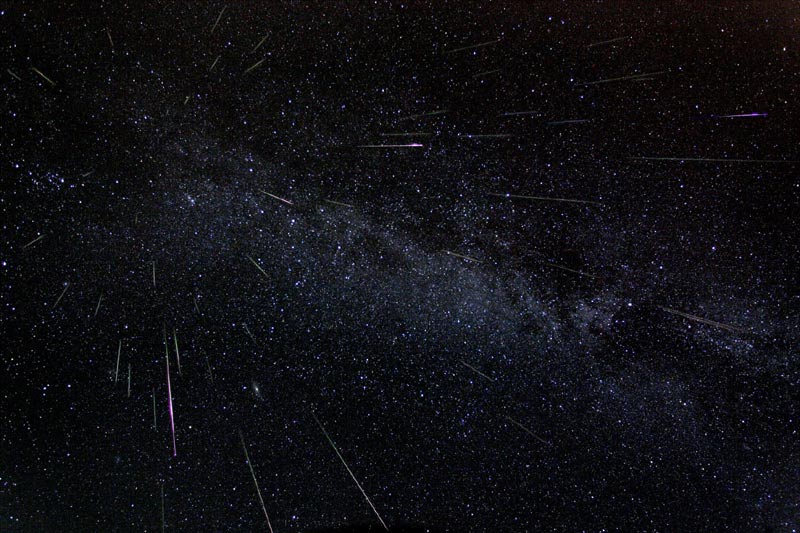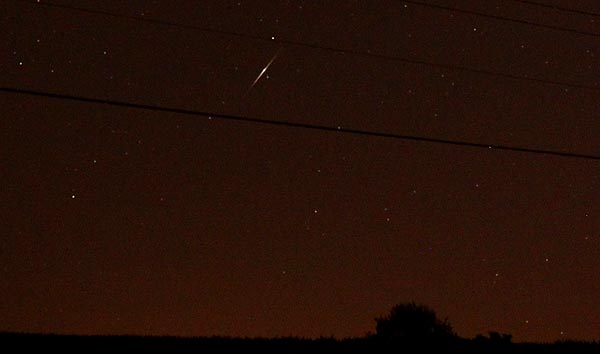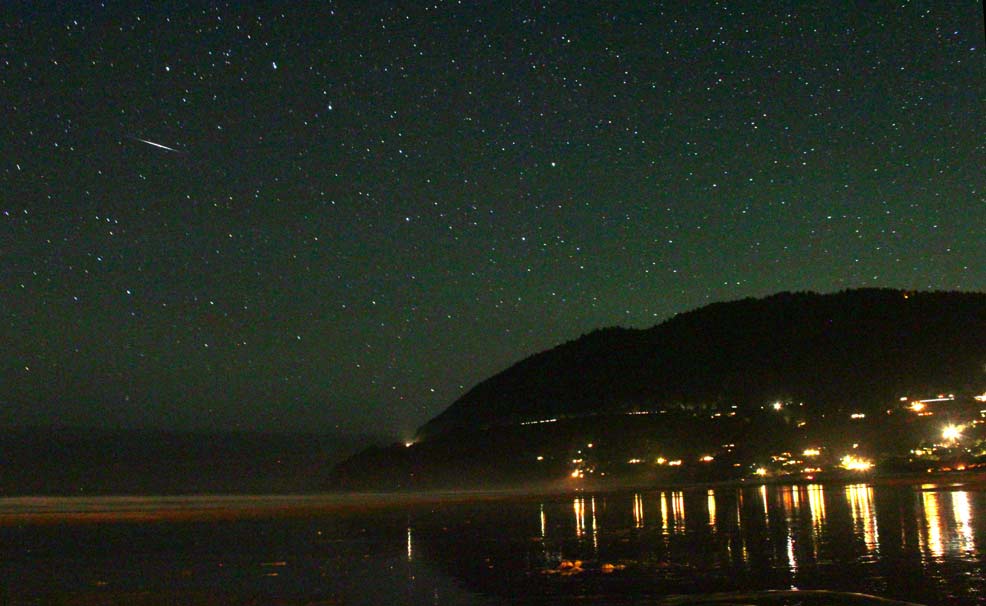Leonid Meteor Showers Peak Soon with Long Trails, 15 per Hour | Oregon Coast Beach Connection
Published 11/11/23 a 7:05 p.m.
By Oregon Coast Beach Connection staff

(Portland, Oregon) – Now is the time to look up if you're on the Washington coast or Oregon coast – or anywhere in the world, for that matter. There are no less than four different meteor showers occurring in November, one of which peaks over the next two nights and another peaks on November 17 – 18. (Photo courtesy NASA)
Includes exclusive listings; some specials in winter
In Cannon Beach:
Includes rentals not listed anywhere else
In Manzanita, Wheeler, Rockaway Beach:
Some specials for winter
In Pacific City, Oceanside:
Some specials for winter
In Lincoln City:
Some specials for winter
In Depoe Bay, Gleneden Beach:
Some specials for winter
In Newport:
Look for some specials
In Waldport
Some specials for winter
In Yachats, Florence
Some specials for winter
Southern Oregon Coast Hotels / Lodgings
Reedsport to Brookings, places to stay; winter deals
The Northern Taurids peak tonight and tomorrow night - November 11 and 12 - with the Southern Taurids still around (although they already peaked). The Orionids peaked last month, but they're still around until November 22.
The big show coming up, however, is the peak of the Leonid meteor showers, happening November 17 – 18.
Meanwhile, another one starts up on November 22, with the Geminids peaking in mid-December.
Jim Todd, astronomy expert with Portland's OMSI, said the moon will be 23% of full and a waxing crescent on the peak of November 17 - 18, which will interfere to some degree with viewing.
“The shower is called Leonids because its radiant, or the point in the sky where the meteors seem to emerge from, lies in the constellation Leo, the Lion,” Todd said. “The Leonids are often bright meteors with a high percentage of persistent trains.”
That means the streak left behind them can be rather long and intense.

Shooting star collage from Portland / Oregon Coast Beach Connection
Debris from Comet Tempel-Tuttle is what creates the Leonids. Todd said it takes the comet about 33 years to complete one orbit around the sun, and when the Earth passes through that stuff left behind it the tiny chunks hit the atmosphere and burn up.
“November’s wonderful Leonid meteor shower happens every year at this time, as our world crosses the orbital path of Comet Tempel-Tuttle,” he said. “It’s when this cometary debris enters Earth’s atmosphere, and vaporizes, that we see the Leonid meteor shower.”
These meteor showers go from November 3 to as late as December 2, and they can produce a decent amount. The trick to seeing them is first dependent on weather (which on the Oregon coast and Washington coast can be a bit tricky), and then it really helps to get out of metropolitan city lights like Seattle or Portland. That's when the coastlines of Oregon and Washington come in handy.
“The peak activity meteor count forecast is about 15 meteors per hour in 2023,” Todd said. “As with most meteor showers, the best time to watch the Leonids is usually between the hours of midnight and dawn.”
See Spectacular Green Fireball Lights Up Oregon Valley Through Washington Coast
Todd said seeing the shower is relatively easy, however. Find a spot that provides a big, wide view of the sky with few obstructions. If you're viewing from the cities, find a darker area, such as an urban park.
See Washington Coast Weather - Oregon Coast Weather
“If you're viewing from the city, try to observe where artificial lights obstruct the least,” Todd said. “Meteor watching is an unaided-eye event but binoculars are handy for watching trails (persistent trains) that may hang in the sky for one or more seconds after a meteor's passage.”
Youcan learn more about the Leonids and the current night sky in Starry Night Live! shown daily in OMSI’s Kendall Planetarium. Visit OMSI.edu for a schedule.
Get deeper into the Washington coast. More photos below:
Oregon Coast Hotels for this event - South Coast Hotels - Where to eat - Maps - Virtual Tours
Cannon Beach Lodging
Nehalem Bay Lodgings
Manzanita Hotels, Lodging
Three Capes Lodging
Pacific City Hotels, Lodging
Lincoln City Lodging
Depoe Bay Lodging
Newport Lodging
Waldport Lodging
Yachats Lodging
Oregon Coast Vacation Rentals
Oregon Coast Lodging Specials



More About Oregon Coast hotels, lodging.....
More About Oregon Coast Restaurants, Dining.....
 Andre' GW Hagestedt is editor, owner and primary photographer / videographer of Oregon Coast Beach Connection, an online publication that sees over 1 million pageviews per month. He is also author of several books about the coast.
Andre' GW Hagestedt is editor, owner and primary photographer / videographer of Oregon Coast Beach Connection, an online publication that sees over 1 million pageviews per month. He is also author of several books about the coast.
LATEST Related Oregon Coast Articles
60s to 70s on the coast while some inland areas may get to 80, even 90. Weather
Summer Road Work, Traffic Issues Along Oregon Coast Include Astoria, Garibald...
Some daylight closures include bridges, OR 22, OR 18, OR 26, more. Travel tips. Seaside, Cannon Beach, Lincoln City. Travel tips
Special Lincoln City Drop Brings Over 100 Glass Floats and Philanthropic Twis...
129 exclusive yellow glass floats June 1 to June 14. Lincoln City events
Bright and Active Arietids Meteors May Hit Pre-Dawn Hours of Oregon, Washingt...
Look to east hour before sunrise and you may catch a show. Sciences, astronomy, weather
Getting Oregon Coast Stays on the 'Lowdown' - Where Lincoln City Cut Rates
Excellent Lincoln City specials abound. Lincoln City hotel reviews
Coos Bay in Summer 2025: Includes History Talk, Oregon Coast Music Festival, ...
Coos Museum Tuesday Talk June 3; Oregon Coast Music Festival Bandon to Coos Bay, July 12 to 26; North Bend July Jubilee July 18 - 20. South Coast events
Washington Coast Cleanup on April 19 - Coinciding with Oregon Coast's SOLVE E...
From the Puget Sound to Long Beach, alongside Oregon's cleanup. Washington coast events, Seaside events
Cannon Beach Sandcastle Contest 2025: N. Oregon Coast Tradition Happens June 21
Started in '64 after a tsunami hit town. Newport events Manzanita events, Cannon Beach events, Seaside events, Astoria events
Back to Oregon Coast
Contact Advertise on Oregon Coast Beach Connection
All Content, unless otherwise attributed, copyright Oregon Coast Beach Connection. Unauthorized use or publication is not permitted




















































